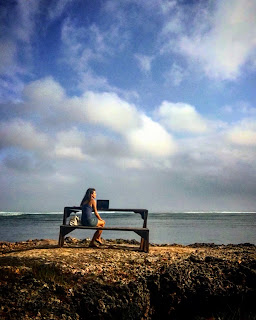Adjustment
There is a finger on the shot - actually there are at least ten. The subject is against the sun, the ocean looks over exposed. Easy to simply state: this is a bad photo.
But how can we work with it?
Is the moment memorable? What’s the story behind the capture? Does it inspire any kind of thought?
Being critical and analytical takes practice.
Likewise, being able to see being flaw to work with what shows up to us is also a helpful skill to master.
We are so wired to look at what does not work and this creates a dark veil which prevents us from seeing what can actually work. And how does this inflexible way of seeing beyond impact our creative thinking?
It is easy to meditate far away up in the mountains somewhere. But can one do that amidst the chaos of traffic and or an argument with an infuriated loved one spitting wasps?
The ability to practice patience and creativity to see solutions can only happen when we can look beyond the problem.
The same happens with the body as it adjusts itself in postures.
In warrior two not only squatting down helps place the thighs in the right angle. Imagining that there is a string that pulls up and from the pelvic floor up to our head helps position hips and glutes and spread toes on the ground to maintain not just balance but also engagement of the inner seams of the legs. This sustains the posture, positions the hips with the right opening and protects all joints involved.
But if the focus is only on squatting to solve the “problem” of adjusting the thighs to being parallel to the floor, then knees can get overloaded, for example.
When we look at adjusting postures and adjusting to different situations in life also from a systemic perspective, it can become easier not to take certain unwanted situations personal. It can help with making it easier to understand that there are ways to adjust in another sphere which can positively influence an outcome which may look problematic and at first unrelated.



Comments